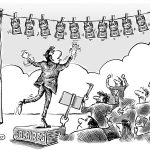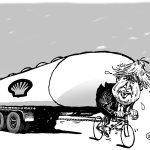A swashbuckling capex trend ahead?
Should fear inflationary anxieties or see the dawn a new era of economic and industrial development?
What if all the inflationary anxieties of recent months were nothing more than false alarms? What if they were swept away by the prospect of a new round of a global investment move that would raise the potential growth of our economies and open a new era of economic and industrial prosperity?
Undoubtedly, the sudden rebound in final demand, combined with changes in consumption habits and the acceleration of industrial transformation, are pushing final prices1 up, and this is already measured in the most recent data. Other surveys suggest that households – particularly in the US – are raising their inflation expectations over the medium term, even beyond those of the market.
The prospect of a recovery in activity, supported on a large scale by public spending, and this over several years, can only reinforce these fears and brings back to the emergence of the scenarios of gradual rise and acceleration of inflation that marked the end of the 60s, until the oil shocks of the following decade. In fact, after the shock of the pandemic, the output gap is closing much faster than during the 2008 crisis.
The oil sector does not seem to be in tune, more inclined to consolidation and deleveraging, and satisfied with allowing energy prices to rise.
Growth of activity above its potential, bottlenecks, alteration of price expectations due to changes in central bank objectives2, increase in debt, it is for many the perfect cocktail for a sustainable return of inflation.
Yet, as reported by The Economist3 magazine, the landscape of 2020 and the beginning of this year is marked by resistance and then the spectacular rebound in business investment. Thus, as early as last year in France, INSEE noted that, unlike in previous cycles, the decline in business investment had not been more marked than that in GDP, which the institute considered unusual and auspicious. Similarly, U.S. S&P500 companies would be willing to accelerate their productive investments, prompting many experts to predict a new boom. Unsurprisingly, the companies that are quickest to go down this road are in the tech sector, and more specifically around the semiconductor industry. Changes in working habits also lead to the need for new equipments, which will have to be met. We have already talked about speeding up the conversion of the car industry to electric power. This will not necessarily affect all sectors. The consequences of the pandemic are still being felt hard in certain activities such as tourism and air transport. Movements in industrial concentrations do not encourage investment. Similarly, the oil sector – and particularly in the US – does not seem to be in tune, more inclined to consolidation and deleveraging, and satisfied with allowing energy prices to rise.
This rebound would, however, affect a majority of the economy and reflect the rise of new industries and the deployment of their capacities. President Joe Biden has just reiterated his intention to support investment with a gigantic multi-year stimulus package. For its part, Europe intends to support these efforts through its plan called “Next Generation”. Such proposals would be part of the overall push towards a new investment cycle. For its part, the IMF forecasts a rebound in the contribution of investment to the economy in both Europe and the United States.
To avert inflation through public-fostered investment, in the eyes of many experts, would be a return to the roots of triumphant Keynesianism. The race is now on.
1 See, among other things, our editorial of May 18, 2021: “Will there be inflation at Christmas? ».
2 After the Federal Reserve, the review of its policy, initiated by the ECB, should lead to the same results.
3 The Economist «The coming capex carnival» May 29th, 2021.
Original text in French published in Allnews.ch June 3rd. ©Cartoon by Barret



